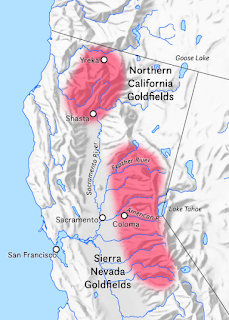On a recent trip to the desert prospecting, I stumbled upon a glint in the sand. I was heading to an area when I caught a sharp flash in my left eye. Bending over for inspection, I found a small quartz pebble with what I first thought was gold.
As you have probably done in the past after the initial excitement, I discovered it only to be pyrite. I still think it is a pretty material, so I usually save it all anyway. Iron sulfide has made many a man a fool! There is a tiny vein of it diagonally and three distinct spots. Anyway, from Wikipedia -
Pyrite's metallic
luster and pale brass-yellow hue give it a superficial resemblance to gold, hence the well-known nickname of
fool's gold. The color has also led to the nicknames
brass,
brazzle, and
Brazil, primarily used to refer to pyrite found in coal.The mineral
pyrite, or
iron pyrite, also known as
fool's gold, is an iron sulfide with the chemical formula FeS
2 (iron(II) disulfide). Pyrite is considered the most common of the sulfide materials.
The name pyrite is derived from the Greek πυρίτης (pyritēs), "of fire" or "in fire",in turn from πύρ (pyr), "fire". In ancient Roman times, this name was applied to several types of stone that would create sparks when struck against steel; Pliny the Elder described one of them as being brassy, almost certainly a reference to what we now call pyrite.
By Georgious Agricola's time, c. 1550, the term had become a generic term for all of the sulfide minerals
Pyrite is usually found associated with other sulfides or oxides in quartz veins, sedimentary rock, and
metamorphic, as well as in coal beds and as a replacement mineral in fossils, but has also been identified in the sclerites of scaly-foot
gastropods. Despite being nicknamed fool's gold, pyrite is sometimes found in association with small quantities of gold. Gold and arsenic occur as a coupled substitution in the pyrite structure. In the Carlin-type
gold deposits, arsenian pyrite contains up to 0.37% gold by weight.










